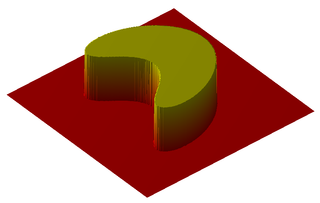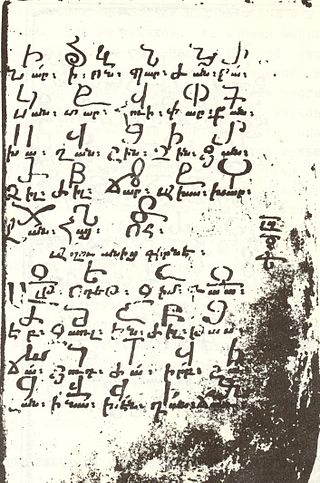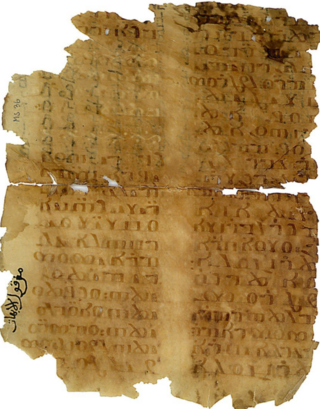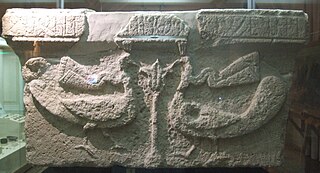
Archimedes of Syracuse was a Greek mathematician, physicist, engineer, astronomer, and inventor from the ancient city of Syracuse in Sicily. Although few details of his life are known, he is regarded as one of the leading scientists in classical antiquity. Considered the greatest mathematician of ancient history, and one of the greatest of all time, Archimedes anticipated modern calculus and analysis by applying the concept of the infinitely small and the method of exhaustion to derive and rigorously prove a range of geometrical theorems. These include the area of a circle, the surface area and volume of a sphere, the area of an ellipse, the area under a parabola, the volume of a segment of a paraboloid of revolution, the volume of a segment of a hyperboloid of revolution, and the area of a spiral.

In textual studies, a palimpsest is a manuscript page, either from a scroll or a book, from which the text has been scraped or washed off so that the page can be reused for another document. Parchment was made of lamb, calf, or kid skin and was expensive and not readily available, so, in the interest of economy, a page was often re-used by scraping off the previous writing. In colloquial usage, the term palimpsest is also used in architecture, archaeology and geomorphology to denote an object made or worked upon for one purpose and later reused for another; for example, a monumental brass the reverse blank side of which has been re-engraved.

In personality typology, the Myers–Briggs Type Indicator (MBTI) is an introspective self-report questionnaire indicating differing psychological preferences in how people perceive the world and make decisions. Despite its popularity, it has been widely regarded as pseudoscience by the scientific community. The test attempts to assign a value to each of four categories: introversion or extraversion, sensing or intuition, thinking or feeling, and judging or perceiving. One letter from each category is taken to produce a four-letter test result, such as "INTJ" or "ESFP".

The Archimedes Palimpsest is a parchment codex palimpsest, originally a Byzantine Greek copy of a compilation of Archimedes and other authors. It contains two works of Archimedes that were thought to have been lost and the only surviving original Greek edition of his work On Floating Bodies. The first version of the compilation is believed to have been produced by Isidorus of Miletus, the architect of the geometrically complex Hagia Sophia cathedral in Constantinople, sometime around AD 530. The copy found in the palimpsest was created from this original, also in Constantinople, during the Macedonian Renaissance, a time when mathematics in the capital was being revived by the former Greek Orthodox bishop of Thessaloniki Leo the Geometer, a cousin of the Patriarch.

In mathematics, an indicator function or a characteristic function of a subset of a set is a function that maps elements of the subset to one, and all other elements to zero. That is, if A is a subset of some set X, one has if and otherwise, where is a common notation for the indicator function. Other common notations are and
The Method of Mechanical Theorems, also referred to as The Method, is one of the major surviving works of the ancient Greek polymath Archimedes. The Method takes the form of a letter from Archimedes to Eratosthenes, the chief librarian at the Library of Alexandria, and contains the first attested explicit use of indivisibles. The work was originally thought to be lost, but in 1906 was rediscovered in the celebrated Archimedes Palimpsest. The palimpsest includes Archimedes' account of the "mechanical method", so called because it relies on the center of weights of figures (centroid) and the law of the lever, which were demonstrated by Archimedes in On the Equilibrium of Planes.

Saint Catherine's Monastery, officially the Sacred Autonomous Royal Monastery of Saint Katherine of the Holy and God-Trodden Mount Sinai, is an Eastern Orthodox Christian monastery located at the foot of Mount Sinai, in the Sinai Peninsula, Egypt. Built between 548 and 565, it is the oldest continuously inhabited Christian monastery in the world.
Teki Dervishi was an Albanian poet, novelist, journalist and playwright.
Gérard Genette was a French literary theorist, associated in particular with the structuralist movement and such figures as Roland Barthes and Claude Lévi-Strauss, from whom he adapted the concept of bricolage.

The Syriac Sinaiticus or Codex Sinaiticus Syriacus (syrs), known also as the Sinaitic Palimpsest, of Saint Catherine's Monastery, or Old Syriac Gospels is a late-4th- or early-5th-century manuscript of 179 folios, containing a nearly complete translation of the four canonical Gospels of the New Testament into Syriac, which have been overwritten by a vita (biography) of female saints and martyrs with a date corresponding to AD 697. This palimpsest is the oldest copy of the Gospels in Syriac, one of two surviving manuscripts that are conventionally dated to before the Peshitta, the standard Syriac translation.

The Caucasian Albanian script was an alphabetic writing system used by the Caucasian Albanians, one of the ancient Northeast Caucasian peoples whose territory comprised parts of the present-day Republic of Azerbaijan and Dagestan.

The Sanaa palimpsest or Sanaa Quran is one of the oldest Quranic manuscripts in existence. Part of a sizable cache of Quranic and non-Quranic fragments discovered in Yemen during a 1972 restoration of the Great Mosque of Sanaa, the manuscript was identified as a palimpsest Quran in 1981 as it is written on parchment and comprises two layers of text. The upper text largely conforms to the standard 'Uthmanic' Quran in text and in the standard order of chapters, whereas the lower text contains many variations from the standard text, and the sequence of its chapters corresponds to no known Quranic order. A partial reconstruction of the lower text was published in 2012, and a reconstruction of the legible portions of both lower and upper texts of the 38 folios in the Sana'a House of Manuscripts was published in 2017 utilising post-processed digital images of the lower text. A radiocarbon analysis has dated the parchment of one of the detached leaves sold at auction, and hence its lower text, to between 578 CE and 669 CE with a 95% accuracy.

The Curetonian Gospels, designated by the siglum syrcur, are contained in a manuscript of the four gospels of the New Testament in Old Syriac. Together with the Sinaiticus Palimpsest the Curetonian Gospels form the Old Syriac Version, and are known as the Evangelion Dampharshe in the Syriac Orthodox Church.

Christian Palestinian Aramaic (CPA) was a Western Aramaic dialect used by the Melkite Christian community in Palestine and Transjordan between the fifth and thirteenth centuries. It is preserved in inscriptions, manuscripts and amulets. All the medieval Western Aramaic dialects are defined by religious community. CPA is closely related to its counterparts, Jewish Palestinian Aramaic (JPA) and Samaritan Aramaic (SA). CPA shows a specific vocabulary that is often not paralleled in the adjacent Western Aramaic dialects.

Galileo Regio is a large, dark surface feature on Jupiter's moon Ganymede.

GNOME Disks is a graphical front-end for udisks. It can be used for partition management, S.M.A.R.T. monitoring, benchmarking, and software RAID. An introduction is included in the GNOME Documentation Project.

Caucasian Albanian is an extinct member of the Northeast Caucasian languages. It was spoken in Caucasian Albania, which stretched from current day south Dagestan to Azerbaijan. Linguists believe it is an early linguistic predecessor to the endangered North Caucasian Udi language. The distinct Caucasian Albanian alphabet used 52 letters.

Palimpsest is a 2009 science fiction novella by Charles Stross, exploring the conjunction of time travel and deep time. Originally published in Stross's 2009 collection Wireless, it won the 2010 Hugo Award for Best Novella.

A palimpsest, in planetary astronomy, is an ancient crater that has been degraded over time. They may also be referred to as "ghost craters", "degraded craters", "buried craters", or "pathological craters". Palimpsests have been identified on Mercury, the Earth, the Moon, Mars, Ganymede, Callisto, and possibly even Titan. On Mars, these features are morphologically described as craters that are "flat-floored, rimless, extremely shallow, without central peaks, and would probably represent what remains after erosion."

Palimpsest is the fifth studio album by Canadian progressive metal band Protest the Hero released on June 18, 2020 through Spinefarm Records. Palimpsest marks the band's first studio record since 2013's Volition, and their first new material since 2016's Pacific Myth EP.
















